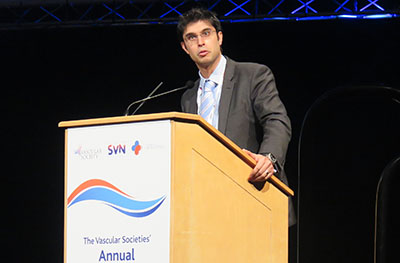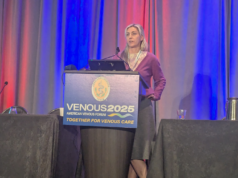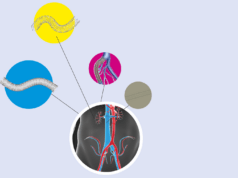
Venous stenting has evolved over the last 15 years, quickly becoming an established procedure, with Class II recommendations from the American Heart Association and American College of Phlebology. Speaking at the Vascular Society of Great Britain and Ireland’s Annual Scientific Meeting (VSGBI; 22–24 November 2017, Manchester, UK), Ankur Thapar presented results from the Venous Research Unit at Imperial College (London, UK) reviewing an expert consensus on antithrombotic therapy following venous stenting.
Following the Class II recommendations, Thapar said the practice of venous stenting has rapidly increased. However, though recommendations for patient selection exist, there is a lack of guidance available regarding antithrombotic therapy following venous stenting.
Describing in-stent thrombosis as the “Achilles Heel” of stenting, Thapar pointed to the importance of optimising antithrombotic care, which currently tends to be extrapolated from deep vein thrombosis (DVT) or arterial stenting strategies.
Thapar and colleagues addressed this knowledge gap by aiming to characterise global practice and identify areas of consensus to inform centres in the process of setting up venous stenting services, as well as to identify research priorities for the community. To examine the trends and practices of venous stenting procedures, the study investigators created a survey for doctors who refer, treat and follow up patients in venous stenting centres.
Collaborating with venous experts, three scenarios of patients with iliac vein stenosis were devised: a case of acute iliofemoral DVT undergoing thrombolysis; post-thrombotic syndrome with ulceration and multiple DVTs and a final scenario of a non-thrombotic lesion with swelling and varices. The three hypothetical cases were sent to a range of international organisations for vascular surgery, haematology and radiology in order to ascertain local practices. In an interim analysis, the 106 survey responses were analysed to create consensus statements, which were then sent back for review and voting. Responses were received from 78 centres in 28 countries, with a majority of respondents being radiologists based within Europe.
Presenting the results, Thapar highlighted the diversity of approaches to venous stenting, commenting, “The community is doing pretty much anything they want at the moment.” However, three strong consensus statements could be made. Firstly, analysis of responses revealed 72% of respondents’ preference for anticoagulation, rather than antiplatelet agents, for the first six to 12 months after stenting a non-thrombotic iliac vein lesion. Secondly, following thrombolysis, 87% of respondents agreed it was acceptable to discontinue anticoagulation after six to 12 months for cases with negative thrombophilia screens and no prior DVTs, providing the stent appearance was satisfactory. Finally, for patients with multiple DVTs, it was agreed by 85% of respondents that anticoagulation should be continued indefinitely.
“Two areas which did not quite hit consensus but are useful because they may inform your practice if you are starting service”, Thapar said, are low molecular weight heparin and thrombophilia screening. The study revealed that 67% of respondents opt for a low molecular weight heparin anticoagulant during the first two to six weeks, “in case they needed to re-intervene during the first admission.” The same percentage of respondents also considered thrombophilia screening to be an essential requirement before discontinuing anticoagulation following DVT thrombolysis—an opinion which radiologists were more likely to hold than haematologists.
However, “no consensus whatsoever” was found on the use of antiplatelet therapy either after stopping anticoagulation. Respondents were also highly divided on whether adding an antiplatelet agent to anticoagulation in a patient with multiple DVTs has “any important clinical benefit”.
The study pointed to a need for UK-based centres to capture data in the National Vascular Registry and initially recommended the use of registry data to assess the primary patency of direct oral anticoagulants vs. vitamin K antagonists following venous thrombolysis and stenting. Further work includes examining the duration of anticoagulation following venous thrombolysis and stenting. The article will shortly be in press in the European Journal of Vascular and Endovascular Surgery.









